Plaridel, Bulacan
Plaridel, officially the Municipality of Plaridel (Tagalog: Bayan ng Plaridel), is a 1st class municipality in the province of Bulacan, Philippines. According to the 2015 census, it has a population of 107,805 people. [3]
Plaridel
Quingua | |
|---|---|
| Municipality of Plaridel | |
 Municipal Hall | |
 Seal | |
| Motto(s): Plaridel, Diretso sa Progreso | |
 Map of Bulacan with Plaridel highlighted | |
OpenStreetMap 
| |
.svg.png.webp) Plaridel Location within the Philippines | |
| Coordinates: 14°53′13″N 120°51′25″E | |
| Country | |
| Region | Central Luzon (Region III) |
| Province | Bulacan |
| District | 2nd District |
| Founded | September 27, 1602 |
| Named for | Pen name of Marcelo H. del Pilar |
| Barangays | 19 (see Barangays) |
| Government | |
| • Type | Sangguniang Bayan |
| • Mayor | Anastacia "Tessie" R. Vistan |
| • Vice Mayor | Imelda "Mhel" G. de Leon |
| • Representative | Gavini C. Pancho |
| • Electorate | 66,381 voters (2019) |
| Area | |
| • Total | 32.44 km2 (12.53 sq mi) |
| Elevation | 11 m (36 ft) |
| Population | |
| • Total | 107,805 |
| • Density | 3,300/km2 (8,600/sq mi) |
| • Households | 24,206 |
| Economy | |
| • Income class | 1st municipal income class |
| • Poverty incidence | 6.02% (2015)[4] |
| • Revenue | |
| • Assets | |
| • Expenditure | |
| Utilities | |
| • Electricity | MERALCO |
| Time zone | UTC+8 (PST) |
| ZIP code | 3004 |
| PSGC | |
| IDD : area code | +63 (0)44 |
| Climate type | tropical monsoon climate |
| Native languages | Tagalog Kapampangan |
| Website | www |
With the expansion of Metro Manila, the municipality is now part of Manila's built-up area which reaches as far north as San Ildefonso, Bulacan.
History

Like many towns in Bulacan, Plaridel has its niche in Philippine history as the site of the Battle of Quingua during the Philippine–American War as part of the defense of the First Philippine Republic against the Northern Campaign of the American Army. The battle, manned by Pablo Tecson—Lt. Colonel Pablo Ocampo Tecson of San Miguel, Bulacan—under Gregorio del Pilar on the side of the First Philippine Republic, led to the death of Col. John Stotsenberg of the American Army on April 23, 1899. A marker now stands at the site of the battle in Barangay Agnaya.
Plaridel's history can be traced through records back to 1581 in the early years of the Spanish colonization. The Augustinian friars from Malolos Convent discovered a vast forest in 1581 then named as Binto; this would later be known as Quingua. As per the history of the Parish of St. James the Apostle, 2001 issue, Quingua was established by the Augustinian Friars of Malolos who initially named it "Encomienda Binto" (Barangay Bintog got its name from this settlement). They built a visita (chapel of ease) and placed it under the jurisdiction of Fray Mateo Mendoza, the prior of Malolos.
The visita of Binto was elevated to an independent parish named Parroquia de Santiago Apostol, and the whole of Quingua was separated from Malolos and was created as a new pueblo on September 27, 1602.
Plaridel is surrounded with the rivers of Angat, Bulacan and Tabang River, both of which run through the town. The Angat River, otherwise known as Bulacan River, flows directly to Calumpit, Bulacan, meeting the Pampanga River. The Tabang River, a tributary with adjoining intersections dividing the middle of the present poblacion of Plaridel, flows to the Manila Bay after passing through the towns of Guiguinto and Bulakan. The water of this river was called "tabáng" to refer to its fresh water.
Initially very few people lived in the town, and most were closely related. Each group had a leader called "tandis". Different groups spoke different languages; Pampango, Pangasinan, Ilocano and Tagalog. From Malolos, the friar curate frequently visited the place, preaching the Catholic faith, using the "balsa" or bamboo raft as his means of transportation. The missionaries decided to clear the land and establish settlements, from which they could work to bring unity to the people. They needed ideas to bring this about, so each "tandis" drew up a plan to pursue. The groups of people labored, so much so that when the priest returned seven years later, he found the area completely cleared. The priests's party inquired among the natives as to whom the credit should go, and the Pampangos exclaimed, "Quing wawa". Thereafter, every now and then, to every question of the friars the people would reply "Quing wa". As a consequence, the place had come to be referred to as Quingua.
During the presidency of Manuel L. Quezon, the then "Alcalde", or Town Mayor, of Quinga, Jose J. Mariano, took the initiative of renaming the town. Representative Pedro Magsalin, a friend of the Alcalde, sponsored the bill changing the name of the town from Quingua to Plaridel. The bill was passed by the Philippine Congress and was approved by the President, and on December 29, 1936 the town was renamed as 'Plaridel', in honor of the great hero of Bulacan, Marcelo H. del Pilar. The celebrations that followed were attended by political luminaries of the time, including Speaker Gil Montilla, Congressman Magsalin, Nicolas Buendia, Eulogio Rodriguez, Elpidio Quirino and Governor José Padilla, Sr.
Notable families from Plaridel include the Vergel de Dios family (originally from Baliuag and that donated the public market of the town), the Castros, Vistans, Sayos, Garcías, and San Diegos.
Barangays
Plaridel is divided into 19 barangays. In 1954, sitio Mayamot in Barrio Banga was changed to Bagong Silang[6] while a sitio in the eastern part of barrio Tabang, called Bagong Silang, was created.[7]
| PSGC | Barangay | Population | ±% p.a. | |||
|---|---|---|---|---|---|---|
| 2015 [3] | 2010 [8] | |||||
| 031417001 | Agnaya | 2.4% | 2,585 | 2,633 | −0.35% | |
| 031417002 | Bagong Silang | 3.1% | 3,322 | 2,775 | 3.49% | |
| 031417003 | Banga I | 6.5% | 7,030 | 6,710 | 0.89% | |
| 031417004 | Banga II | 8.4% | 9,036 | 8,775 | 0.56% | |
| 031417005 | Bintog | 3.8% | 4,122 | 3,930 | 0.91% | |
| 031417006 | Bulihan | 5.3% | 5,721 | 5,404 | 1.09% | |
| 031417007 | Culianin | 3.8% | 4,130 | 4,177 | −0.22% | |
| 031417008 | Dampol | 3.0% | 3,183 | 3,111 | 0.44% | |
| 031417010 | Lagundi | 3.9% | 4,243 | 4,135 | 0.49% | |
| 031417011 | Lalangan | 1.9% | 2,077 | 1,923 | 1.48% | |
| 031417012 | Lumang Bayan | 5.0% | 5,361 | 4,370 | 3.97% | |
| 031417014 | Parulan | 7.0% | 7,590 | 8,461 | −2.05% | |
| 031417015 | Poblacion | 3.6% | 3,901 | 3,907 | −0.03% | |
| 031417016 | Rueda | 1.7% | 1,803 | 1,788 | 0.16% | |
| 031417017 | San Jose | 4.1% | 4,448 | 4,197 | 1.11% | |
| 031417018 | Santa Ines | 2.7% | 2,953 | 2,319 | 4.71% | |
| 031417019 | Santo Niño | 10.0% | 10,761 | 9,744 | 1.91% | |
| 031417020 | Sipat | 5.4% | 5,856 | 5,367 | 1.67% | |
| 031417021 | Tabang | 18.3% | 19,683 | 17,715 | 2.03% | |
| Total | 107,805 | 101,441 | 1.17% | |||
Climate
| Climate data for Plaridel, Bulacan | |||||||||||||
|---|---|---|---|---|---|---|---|---|---|---|---|---|---|
| Month | Jan | Feb | Mar | Apr | May | Jun | Jul | Aug | Sep | Oct | Nov | Dec | Year |
| Average high °C (°F) | 28 (82) |
29 (84) |
31 (88) |
33 (91) |
32 (90) |
31 (88) |
30 (86) |
29 (84) |
29 (84) |
30 (86) |
30 (86) |
28 (82) |
30 (86) |
| Average low °C (°F) | 20 (68) |
20 (68) |
21 (70) |
22 (72) |
24 (75) |
24 (75) |
24 (75) |
24 (75) |
24 (75) |
23 (73) |
22 (72) |
21 (70) |
22 (72) |
| Average precipitation mm (inches) | 6 (0.2) |
4 (0.2) |
6 (0.2) |
17 (0.7) |
82 (3.2) |
122 (4.8) |
151 (5.9) |
123 (4.8) |
124 (4.9) |
99 (3.9) |
37 (1.5) |
21 (0.8) |
792 (31.1) |
| Average rainy days | 3.3 | 2.5 | 11.7 | 6.6 | 17.7 | 22.2 | 25.2 | 23.7 | 23.2 | 17.9 | 9.2 | 5.2 | 168.4 |
| Source: Meteoblue [9] | |||||||||||||
Demographics
| Year | Pop. | ±% p.a. |
|---|---|---|
| 1903 | 7,229 | — |
| 1918 | 8,216 | +0.86% |
| 1939 | 11,161 | +1.47% |
| 1948 | 14,290 | +2.78% |
| 1960 | 18,714 | +2.27% |
| 1970 | 27,648 | +3.98% |
| 1975 | 32,613 | +3.37% |
| 1980 | 39,121 | +3.70% |
| 1990 | 52,954 | +3.07% |
| 1995 | 66,355 | +4.32% |
| 2000 | 80,481 | +4.22% |
| 2007 | 97,225 | +2.64% |
| 2010 | 101,441 | +1.56% |
| 2015 | 107,805 | +1.17% |
| Source: Philippine Statistics Authority [3] [8] [10][11] | ||
In the 2015 census, the population of Plaridel, Bulacan, was 107,805 people, [3] with a density of 3,300 inhabitants per square kilometre or 8,500 inhabitants per square mile.
Housing Development
The growing population of Plaridel, Bulacan increased the demand and magnified the needs for economic and socialized housing in the area. Several housing developers such as Bria Plaridel, Lumina Residences Bulacan, and Lessandra Provence gave the opportunity to the locals of Plaridel to obtain affordable homes that even minimum wagers can afford. These housing developments rose into prominence when they provided quality and affordable housing in safe and secure communities. With the country’s population increasing and the loss of thousands of homes to natural disasters, there currently exists a massive housing deficit and having housing developments in Plaridel is an answer to the call of the government.
Attractions
Parish Church of Santiago Apostol
The Plaridel Church was initially a mission chapel built by the Augustinians in Malolos made of light materials. The Chapel was located near River at Lumang Bayan and transferred to present site. It is clearly evident why the said Barrio named Lumang Bayan means-Old Poblacion. From 1590 to 1602, Quingua was administered by Friar Curate from Malolos Church which close at hand.
The present church was built in 1602 and established as the town church of the newly created Pueblo de Quingua.
Plaridel is one of the earliest settlement to be established at around 1590 as Encomienda. Its Parish Church of Santiago Apostol has one of the unique Moorish architectural style among the Augustinian Churches in the province. It was here that the money and jewels of san Agustin in Intramuros, Manila were kept during British Occupation in 1762-63.
The church is small and its two level facade is bare. However, the crowning pediment is elaborate consisting of a pair of volutes with the inner space filled with triangular patterns and floral embellishments that first glance can be mistaken as having a Moorish influence because of the minaret like dome formed. In between the volutes are a series of spaced relieves of cherubs, ramilletes, two saints including that of St. Agustin and the pierced heart which is the symbol of the Agustinia Order. The octagonal and tapering belltower on the other hand sits on a quadrilateral base and rises 4 levels.
The Parish Church of Santiago Apostol is the location of GMA Network's Fantaserye Darna (2009), Zaido (2007), Iglot (2011) and afternoon drama series, Nita Negrita (2011), Broken Vow (2012). And the Judy Ann Santos-Sarah Geronimo Movie Hating Kapatid in July 2010.
And recently, ABS-CBN's drama anthology Maalaala mo kaya: Toga, starring Albie Casiño and Erich Gonzales and the episode of Police Uniform" starring Empress and Joseph Marco.
Salubong Festival or Horse Festival
Salubong Festival celebrated annually every December 29. It's called salubong or welcome because they welcome the St. James the Greater's equestrian replica from Sipat. It's also called Horse festival because they paraded calesas, tiburins (non-roofed calesa) and an only riding on the horse (equestrian) and holding a horse racing in the afternoon.
Other Attractions
- Battle Of Quingua Monument
- Walter Mart Plaridel
- Puregold Plaridel
- Primark Town Center Plaridel
- Plaridel Airport
- Grass Garden Resort and Villas
- Villa Emmanuela Wavepool & Resort
- Eugenio's Garden Resort
- Sir Nico Guesthouse and Resort
- Samarah private Resort Bintog Plaridel
Gallery
 Downtown Plaridel
Downtown Plaridel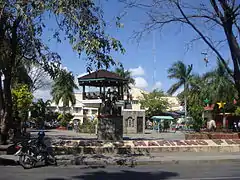 Don Jose J. Mariano Park
Don Jose J. Mariano Park Marcelo H. Del Pilar Statue in front of the Municipal Hall
Marcelo H. Del Pilar Statue in front of the Municipal Hall Don Jose J. Mariano Statue
Don Jose J. Mariano Statue World War II Veterans Memorial Statue
World War II Veterans Memorial Statue Don Cesario Muti-purpose Gymnasium
Don Cesario Muti-purpose Gymnasium Control tower of Plaridel Airport, parked planes and aviation schools
Control tower of Plaridel Airport, parked planes and aviation schools Overview of the interior of Parish of St. James the Apostle
Overview of the interior of Parish of St. James the Apostle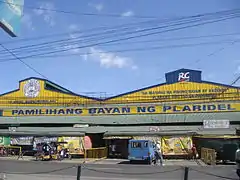 Plaridel Wet and Dry Public Market
Plaridel Wet and Dry Public Market La Consolacion University General Hospital (formerly University of Regina Carmeli)
La Consolacion University General Hospital (formerly University of Regina Carmeli) Battle of Quingua Memorial
Battle of Quingua Memorial Walter Mart Plaridel
Walter Mart Plaridel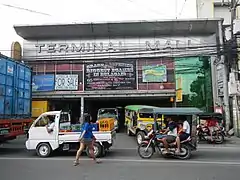 Plaridel Terminal Mall
Plaridel Terminal Mall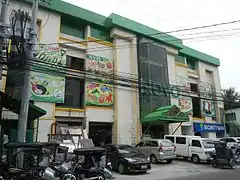 Novo Department Store Plaridel
Novo Department Store Plaridel Plaridel Municipal Slaughter house
Plaridel Municipal Slaughter house San Miguel Arkanghel Parish Church
San Miguel Arkanghel Parish Church San Nicolas de Tolentino Chapel
San Nicolas de Tolentino Chapel Nuestra Señora del Rosario Chapel
Nuestra Señora del Rosario Chapel Chapel of the Holy Cross
Chapel of the Holy Cross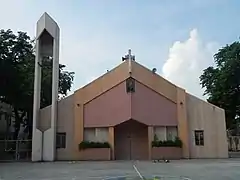 Saint Anthony of Padua Chapel
Saint Anthony of Padua Chapel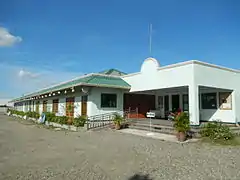 Holy Angels Quasi-parish Church
Holy Angels Quasi-parish Church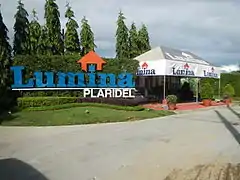 Lumina Homes Plaridel
Lumina Homes Plaridel
References
- Municipality of Plaridel | (DILG)
- "Province: Bulacan". PSGC Interactive. Quezon City, Philippines: Philippine Statistics Authority. Retrieved 12 November 2016.
- Census of Population (2015). "Region III (Central Luzon)". Total Population by Province, City, Municipality and Barangay. PSA. Retrieved 20 June 2016.
- "PSA releases the 2015 Municipal and City Level Poverty Estimates". Quezon City, Philippines. Retrieved 1 January 2020.
- ""Commission on Audit 2017 Report-Bulacan"". Quezon City, Philippines: Commission on Audit. Retrieved 8 July 2018.
- "An Act Changing the Name of the Sitio of Mayamot, Barrio of Banga, Municipality of Plaridel, Province of Bulacan, to Bagong Silang". LawPH.com. Retrieved 2011-04-09.
- "An Act Creating a Sitio in the Eastern Part of Barrio Tabang, Municipality of Plaridel, Province of Bulacan, to Be Known As the Sitio of Bagong Sikat". LawPH.com. Retrieved 2011-04-09.
- Census of Population and Housing (2010). "Region III (Central Luzon)". Total Population by Province, City, Municipality and Barangay. NSO. Retrieved 29 June 2016.
- "Plaridel: Average Temperatures and Rainfall". Meteoblue. Retrieved 12 May 2020.
- Censuses of Population (1903–2007). "Region III (Central Luzon)". Table 1. Population Enumerated in Various Censuses by Province/Highly Urbanized City: 1903 to 2007. NSO.
- "Province of Bulacan". Municipality Population Data. Local Water Utilities Administration Research Division. Retrieved 17 December 2016.
External links
| Wikimedia Commons has media related to Plaridel, Bulacan. |